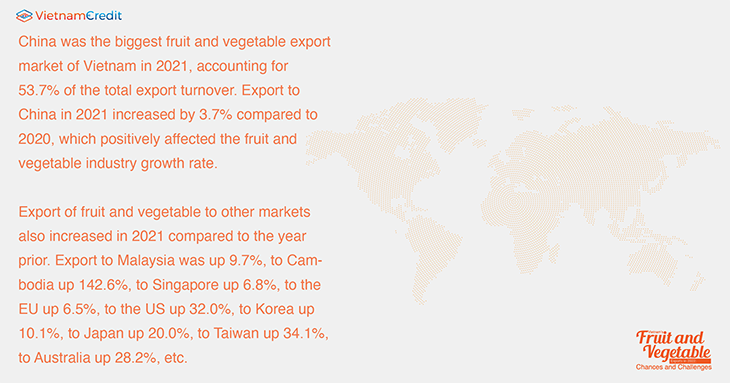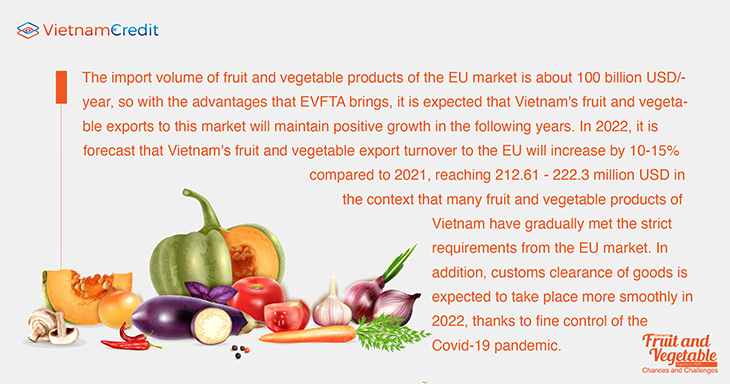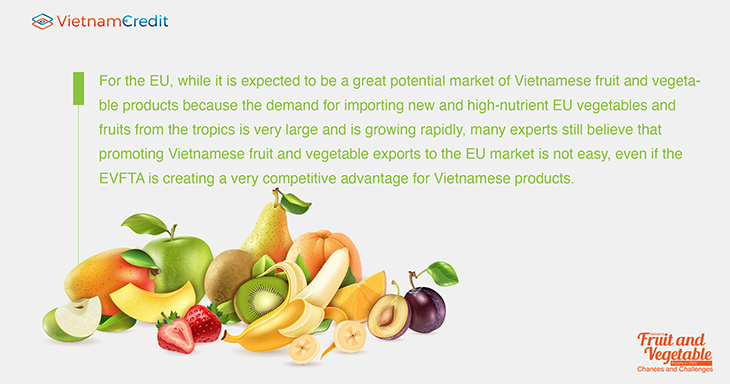OVERVIEW OF VIETNAM’S FRUIT AND VEGETABLE EXPORTS IN 2021
Vietnam’s fruit and vegetable export in the first half of 2021 boosted the whole year’s exports of these products, resulting in a fair growth rate for Vietnam’s fruit and vegetable industry despite the impact of the fourth pandemic outbreak.
According to the General Department of Customs statistics, Vietnam’s fruit and vegetable export turnover in December 2021 reached 299.4 million USD, up 14.5% compared to November 2021 and 9.1% over December 2020. For the whole year of 2021, Vietnam’s fruit and vegetable export turnover reached 3.55 billion USD, up 8.6% compared to 2020.
China was the biggest fruit and vegetable export market of Vietnam in 2021, accounting for 53.7% of the total export turnover. Export to China in 2021 increased by 3.7% compared to 2020, which positively affected the fruit and vegetable industry growth rate.

Export of fruit and vegetable to other markets also increased in 2021 compared to the year prior. Export to Malaysia was up 9.7%, to Cambodia up 142.6%, to Singapore up 6.8%, to the EU up 6.5%, to the US up 32.0%, to Korea up 10.1%, to Japan up 20.0%, to Taiwan up 34.1%, to Australia up 28.2%, etc.
PROSPECTS FOR 2022: EU AS A PROMISING MARKET
Vietnam’s fruit and vegetable industry stands before great chances to boost export activities in 2022. The EVFTA brought the industry benefits in 2021. In particular, before the EVFTA took effect, Vietnamese vegetables and fruits exported to the EU market enjoyed a preferential tax rate under the Generalized System of Preferences (GSP), but the rate was still at a relatively high level of 10-20%. From August 1, 2020, when the EVFTA came into effect, about 94% of the total 547 tax lines for fresh and processed vegetables and fruits were reduced to 0% by the EU, including many major fruit and vegetable export products of Vietnam.
The import volume of fruit and vegetable products of the EU market is about 100 billion USD/year, so with the advantages that EVFTA brings, it is expected that Vietnam’s fruit and vegetable exports to this market will maintain positive growth in the following years. In 2022, it is forecast that Vietnam’s fruit and vegetable export turnover to the EU will increase by 10-15% compared to 2021, reaching 212.61 – 222.3 million USD in the context that many fruit and vegetable products of Vietnam have gradually met the strict requirements from the EU market. In addition, customs clearance of goods is expected to take place more smoothly in 2022, thanks to fine control of the Covid-19 pandemic.

According to data from the European Statistical Office, the EU’s import turnover of fruit and vegetables in the first ten months of 2021 reached 156.72 billion EUR, up 1.3% over the same period in 2020. In which, the EU imported fruit and vegetable products from Vietnam reached 254.73 million EUR, up 18.9%. Vietnam’s market share of fruit and vegetables in total EU imports increased from 0.14% in 10 months of 2020 to 0.16% in 10 months of 2021.
CHALLENGES FROM BIG MARKETS
China was Vietnam’s biggest fruit and vegetable export market in 2021. In 2022, it is predicted that exporting to this country will be more challenging.
Mr. Tran Thanh Hai, Deputy Director General of the Agency of Foreign Trade (under the Ministry of Industry and Trade), stated that from January 1, 2022, China would continue to tighten the conditions for importing agricultural products, and many measures to manage imported food safety would be applied. The requirements from China are gradually approaching developed countries. Therefore, enterprises need to pay attention to strictly comply with this country’s import regulations to avoid export disruption.
For the EU, while it is expected to be a great potential market of Vietnamese fruit and vegetable products because the demand for importing new and high-nutrient EU vegetables and fruits from the tropics is very large and is growing rapidly, many experts still believe that promoting Vietnamese fruit and vegetable exports to the EU market is not easy, even if the EVFTA is creating a very competitive advantage for Vietnamese products.

Vietnam does not have a large enough cultivating area to ensure quality and stable supply for exports to the EU. Enterprises that are internationally certified and certified to meet EU standards are few. The technology of preservation and processing is still limited, and the packaging and labeling design are not suitable for the tastes of EU citizens. In addition, transportation costs are high, affecting product distribution costs and reducing competitiveness compared with similar products of other countries in the EU market.
According to Deputy Minister of Industry and Trade, Mr. Do Thang Hai, consumption in the import market due to the impact of the COVID-19 pandemic is still a big challenge. Therefore, the Ministry of Industry and Trade is continuing to coordinate with the Ministry of Agriculture and Rural Development to analyze and make specific assessments of the markets, thereby helping fruit and vegetable producers and enterprises orient production, build business strategies, and take advantage of FTAs.
Source: VietnamCredit

